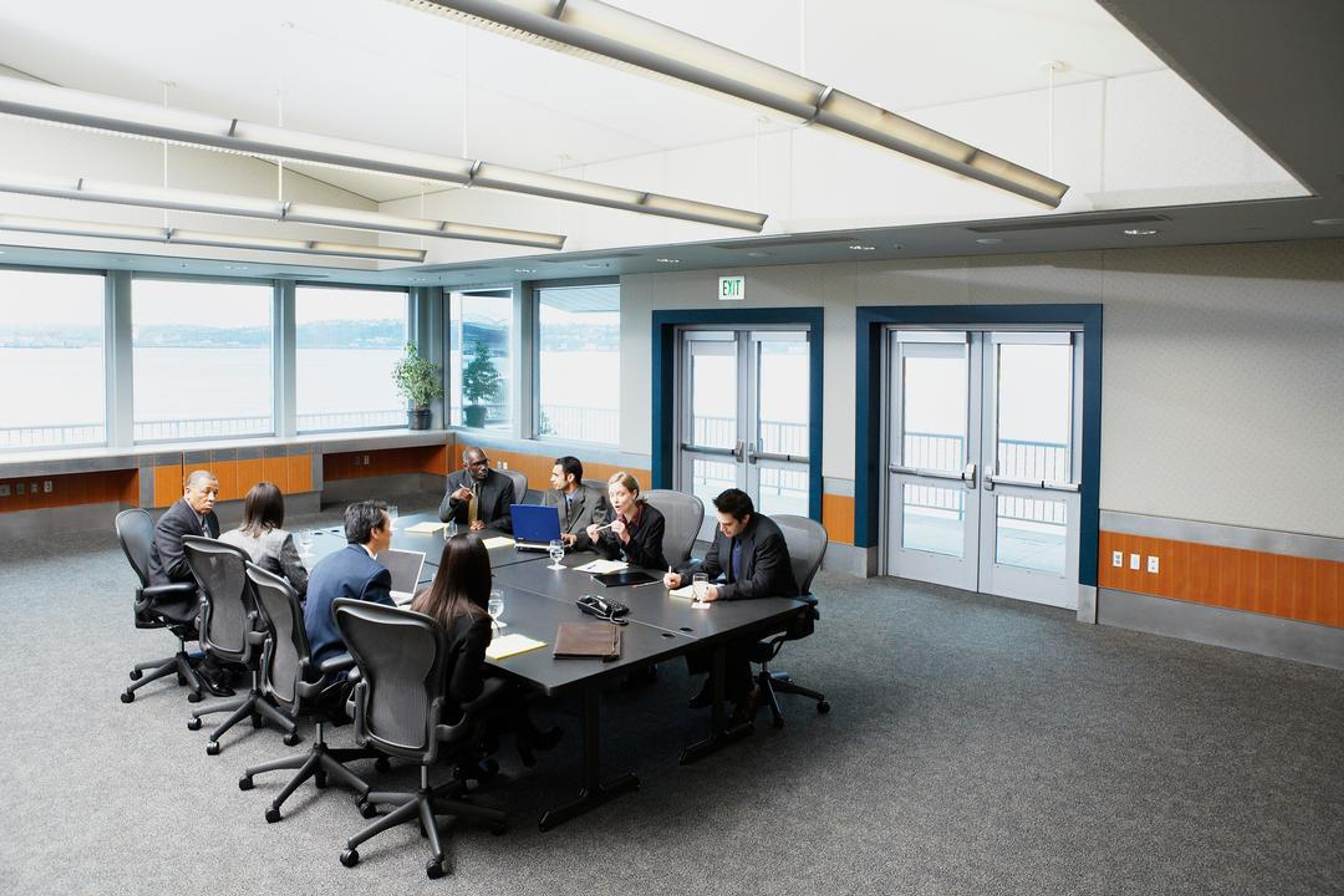How to take effective meeting minutes (with templates)

Meeting minutes are a routine duty but should not be taken lightly. According to the Harvard Law School Forum on Corporate Governance, "Boards should see minutes as a way to tell how they worked to fulfill their duties to stockholders.” They are also an official written record of a meeting; the most effective meeting minutes will offer a clear picture of what happened there. These are a critical element of corporate and board meetings, shareholder meetings and more, and they’re not just for those who couldn’t attend in person.
Without meeting minutes, details about executive meeting decisions, task assignments and other organizational actions may become hazy over time and could put the board at legal risk. Meeting minutes are proof of why and how a board came to the decisions it made. The IRS, state laws, and your national chapter (if applicable) may require you to retain your meeting minutes.
For all these reasons, board meeting minutes must accurately reflect the actions and decisions of the board. To help you take more effective meeting minutes, this article will explain:
- What meeting minutes are
- What is considered effective meeting minutes
- How to take meeting minutes effectively
- Tips, templates and technology for better meeting minutes
What makes effective meeting minutes?
Meeting minutes record a board’s or committee’s actions and deliberations during a meeting. But effective meeting minutes do more. They must simultaneously convey the discussions and decisions during the meeting and contain specific components that support good corporate governance and protect the board and the organization from undue or unexpected legal allegations. Board meeting minutes should also note advisors’ participation in the meeting and whether the board relied on the experts’ advice.
“Directors are likely to face stockholder litigation at some point,” explained Amy Zimmerman, Partner, Wilson Sonsini Goodrich & Rosati. “Minutes really are the first evidence that is put out there. Their go-to evidence for judges and for plaintiff’s attorneys. The judges have said again and again in Delaware how important minutes are.” She emphasized that if something is not in the minutes, there will be a presumption that the board did not do it. So, how can you do this critical task effectively?
The order of items, how they’re titled, and the degree of detail are less important than the meeting activities. It’s more critical for minute-takers to record the actions and decisions of the board and the rationale behind their actions and decisions without so much detail as to cloud their true intentions.
Why taking effective meeting minutes matters
Meeting minutes are vital records that align boards and hold them accountable for their decisions. Whether the board is making mission-critical decisions or tracking action items, effective minutes ensure everyone is on the same page and that nothing falls through the cracks.

Here’s how they matter to different roles:
- Corporate secretaries: Responsible for creating and maintaining official records. They rely on accurate minutes to uphold good governance, support board functionality, and ensure the organization meets compliance and reporting obligations.
- Executives: With limited time and competing priorities, executives use minutes to quickly understand key decisions, track progress on strategic initiatives and stay aligned with the board and leadership team.
- Board members: As fiduciaries, board members need clear, well-documented minutes to validate decision-making processes, revisit past discussions and fulfill their oversight role with confidence and continuity.
- Legal and compliance teams: Minutes serve as a critical audit trail for legal and regulatory purposes. They help demonstrate that the organization follows proper procedures, manages risk appropriately and makes decisions in good faith.
In this episode of Inside Today’s Boardrooms, Amy Simmerman discusses why effective board minutes are so important and what every director should be aware of when approving them.
Before the meeting: Setting yourself up to take meeting minutes effectively
The quality of your meeting minutes starts before anyone walks into the room. Here's a guide on how to take effective meeting minutes that maximize the productivity of the meeting.
- Prepare for the meeting: Collaborate with the meeting leader to ensure the agenda is well-planned and productive. Try obtaining a copy of the meeting agenda to help develop an outline and structure your minutes. The outline should leave ample space to write a brief explanation for each action or motion and the time each action was taken.
- Review the meeting agenda: Organize your notes by writing the agenda item each minute corresponds to. This makes it clear what each minute is about and eliminates the guesswork. Agendas also provide key details that need to be included in the minutes, such as the names of meeting attendees and guest speakers.
- Set up your template: Align your meeting minutes template with your organization’s standards. Include sections for attendees, agenda items, motions, decisions, action items and next steps. Many board portals include templates, or you can use the template provided below.
- Bring the right tools: Whether you prefer meeting minutes software or pen and paper, use tools to record information quickly and stay organized.
Effortless meeting preparation
Streamline your meeting preparation and minute-taking with Diligent Boards. Try it now to save time and enhance efficiency.
Discover moreHow to take effective minutes during a meeting
The best minute-takers are great listeners. Once the meeting begins, use your template and follow the conversation to discern the key discussion and decisions you’ll record.
- Mark attendance: As meeting participants walk in, you can cross them off your attendee list if you’re familiar with them. If you’re not, you can pass around a sign-in sheet or begin the meeting with quick introductions. This makes it easier to identify people who could not attend the meeting.
- Focus on the most critical aspects of the meeting: Concentrating on minutiae will lead you to miss the larger context. Instead, convey objectively what attendees discussed and the outcomes of those discussions, including how board members voted on various resolutions.
- Ask for clarification: Speak up if you need clarification on outcomes, particularly if a clear decision wasn’t made or if the next steps weren’t obvious. Remember to record notes for each decision or action as it occurs.
After the meeting
When the meeting adjourns, the true minute-taking begins. This is where you’ll turn the notes in your template into a formal meeting minutes document that will become part of the corporate record.
- Immediately write the final version: A common misconception is that what you record during the meeting is final. The reality is that you can take time after the meeting adjourns to finalize your notes. Review your notes to ensure they’re genuinely effective meeting minutes, and if needed, add notes for clarity or ask the meeting leader to explain specific details further. Ensure that each action the board takes has a brief explanation and a rationale for the decision.
- Organize supplemental materials: If other documents were included in the meeting, note where they can be found or attach them as an appendix, but don't summarize them.
- Distribute the minutes: Securely send the meeting minutes to the board for review before finalizing them. The most efficient and secure option is to distribute the minutes via email using a password-protected PDF or a collaborative board portal. You should also store a hard copy for future reference.
- Store the minutes: Be sure to back them up to an external hard drive as an extra precaution unless you’re using a service that includes good co-location and disaster recovery services. Many minutes contain sensitive information, so it’s critical to store them in a password-protected secure location and only accessible to approved meeting members; many boards use an encrypted board portal to keep minutes out of the wrong hands.
Effective meeting minutes template
There’s no shortage of templates for effective meeting minutes. Most corporations start with a basic format, which evolves according to the company’s needs. Boards may select from the components below and include them in their meeting minutes format.
Name and corporate logo
Board minutes should list the corporation's name at the top of the letterhead. Most companies also add their logo, corporate headquarters address, phone number and website address.
Date and location
Usually, board meeting minutes list the month, day and year of the meeting. This section also lists whether it’s a regular, annual, special or emergency meeting. The location of the meeting follows this information and may state whether all or some portion of the meeting will be held by teleconference or videoconference.
Attendees
This list of meeting attendees typically comes next. This section lists the board members who were present, those who were absent and whether a quorum was present. The attendee’s list includes any special presenters, outside counsel, experts or guests.
Agenda
This is the point in the meeting where things often change. It doesn’t matter what order the committee reports are listed in or whether the board chooses to assess how their meeting went briefly. It’s just essential to record the main actions and decisions of the board. Any order works fine. Effective meeting minutes will follow a consistent format for litigation or questions on board actions. Many boards find it helpful to list agenda items corresponding to the action the board needs to take. Formatting minutes like this simplifies the task for minute-takers. For example, each agenda item may be followed by one of the following words:
- Information
- Discussion
- Decision
- Accept
Proceedings
The proceedings detail the items the board discussed in the order they discussed them. The minutes should reflect who called the meeting to order and the time the person called the meeting to order. Typically, this is the board chair, but it could be someone else if the board chair is absent for any reason.
Reports
The chief executive usually submits a report for every meeting detailing the state of the corporation since the last meeting, including any new developments and challenges. The chief executive's report is usually followed by standing committee reports and ad hoc committee reports. Standing committees may include the finance committee, the executive committee, and the nominating and governance committee. Ad hoc committees tackle specific objectives or tasks and are usually dissolved after they achieve those objectives.
Unfinished business or old business
Many corporations still use the term 'old business' to refer to agenda items that they carried over from the previous meeting. A term that more accurately describes this section is unfinished business because the items may not be old at all, and the board may just need additional time to address them.
New business
These are new items on the agenda that the board has not yet discussed. They are often accompanied by reports, articles, research or other supporting documentation.
Open dialogue
Not all boards allow time for open dialogue. Whether boards include this section speaks to the tradition and culture of the board. Having an open dialogue enables board directors to discuss matters that don’t fit neatly into other parts of the agenda.
Public participation
Some corporations hold public meetings at least some of the time. If so, effective meeting minutes should reflect that members of the public attended the meeting and make note of the issues they presented. The board may ask questions of individuals from the public, but they normally don't answer them directly during the meeting.
Comments and announcements
This portion of the minutes documents comments on industry issues or other important matters. This is also a time for the board chair to make announcements of board directors who will be appointed or are leaving. This section includes honoring board directors for special achievements.
Assessment of meeting
To streamline their meetings and increase productivity, some boards allow a short amount of time at the end of the board meeting for members to comment on how well the board meeting was run and where they can improve the process.
Adjournment
The final words list who called for the adjournment of the meeting and at what time the meeting was adjourned.
Minute-taker
The person taking minutes should list their name and title.

Tips for taking effective meeting minutes
Taking effective meeting minutes is something of an art and a science, blending the board’s unique culture with the components of good corporate governance. To take the most effective minutes possible, secretaries should strive to:
- Use consistent language: Minutes should be written using consistent language and a consistent approach. Meeting minutes can be called into court, so they must contain clear, concise and unambiguous information so that court officials won't need to seek other sources to clarify or substantiate information.
- Balance detail levels: Not every little thing needs to be documented. It is crucial to include the critical elements of a board meeting. This includes the topics the directors considered, the reasons for their decisions, and who they received advice from. The duration and content of the board's discussion, as well as the company's industry, all impact the amount of detail that should be included in the board minutes. Megan Baier, Partner with Wilson Sonsini Goodrich & Rosati, advises on whether board members should ask to have their dissent recorded. “If a board member decides, ‘I want to dissent and have it noted in the minutes,’ whether that would shield you from any related liability is more situational,” Baier explained.
- Limit blow-by-blow legal advice: During Inside Today's Boardrooms, Zimmerman recommended against including too much blow-by-blow legal advice in the minutes. This is because in the event that legal privilege is waived, it gives the plaintiffs a lot of information about legal advice that you don't want in there.
- Remain objective: Use neutral language whenever possible and steer clear of adjectives and adverbs that reflect value judgments.
- Correct errors: Minute-takers and the board chair or board president should carefully review and edit the minutes to correct any typographical errors and other misleading information that could call the entire record into question.
- Disclose conflicts: Meeting minutes should reveal any conflicts of interest and how the board resolved them.
- Mention if an attorney was present: Effective meeting minutes should reflect whether the board held privileged discussions with their attorney and, if so, simply indicate that the board participated with their legal counsel and provide the most general reference information available.
- Reflect executive sessions: The NYSE requires board directors of publicly listed corporations to meet in regularly scheduled executive sessions where management isn't present to allow for candid discussions among independent directors. Minutes should reflect that the board held this meeting, who attended it, when the meeting was held and how long the meeting lasted.
- Seek oversight: Excellence and diligence in minute-taking ensure that best practices for good corporate governance are linked to disclosure controls and procedures. The individual who takes minutes should have guidance and oversight by another individual who has the proper experience and education to employ best practices to foster excellence in governance.
- Leverage AI: Meeting minutes software powered by AI can streamline your meeting minutes workflow while maintaining accuracy. Automatically capture the date, time, and attendance and translate your notes into complete meeting minutes — all with just a click.
Role-based best practices for strong meeting minutes
How you approach effective meeting minutes will vary based on your role. However, the goal is always the same: clear, accurate documentation that supports informed decision-making and accountability.
Corporate secretaries
- Standardize your format: A consistent template can expedite meeting minutes reviews and ensure all required elements (motions, votes, decisions) are included every time.
- Document, don’t editorialize: Focus on capturing facts and outcomes, not opinions or commentary.
- Track follow-ups: Note action items, responsible parties and deadlines to support board accountability.
- Ensure timely distribution: Circulate minutes promptly for review and approval while the meeting is still fresh. This enables the board to provide more accurate feedback if any changes are needed.
Department heads and executives
- Skim for strategy: Focus on summaries, paying particular attention to decisions, directions and any strategic next steps. This can help ensure alignment with any upcoming department initiatives.
- Highlight action items: Make it easy to identify which items need follow-up by you or your department. Keeping the minutes and action items front of mind ensures your work aligns with the board’s priorities.
- Avoid duplication: Reference attached reports or decks rather than rewriting what’s already documented. This makes the minutes more usable and focuses your attention on key discussion points and decisions.
- Use minutes as an internal alignment tool: After the meeting, share relevant excerpts with your team. Highlight key takeaways and decisions to keep everyone informed and on track.
Board members
- Focus on oversight and governance decisions: Note how decisions are framed and recorded, especially regarding financials, strategic plans and risk management. Minutes should reflect that the board exercised its fiduciary duties.
- Review for accuracy and context: Read through minutes critically to ensure they reflect what actually happened, including your contributions. Speak up during the approval process if anything seems off or incomplete.
- Flag any gaps or concerns: If motions, votes, or discussions are missing or unclear, request clarification before the minutes are finalized. Your vigilance helps maintain a clear historical record.
- Use minutes to stay grounded between meetings: Revisit past meeting minutes before the next session to refresh your memory, follow up on open items and maintain continuity from one meeting to the next.
Legal and compliance professionals
- Ensure proper procedural language is included: Verify that meeting minutes reflect adherence to bylaws, quorum requirements and voting protocols. This helps ensure compliance with internal and external governance standards.
- Capture key legal elements and disclosures: Look for documentation of conflict of interest disclosures, board approvals of contracts or policies, and discussions on legal risk or regulatory exposure.
- Draft with a legal lens: Assume meeting minutes could be subpoenaed or reviewed during an audit or investigation. Avoid vague or speculative language and focus on facts, decisions and official statements.
- Archive securely and systematically: Store final, approved minutes in a secure, searchable format that complies with retention policies. Ensure appropriate access for legal, board and compliance personnel.
Tools for taking more effective minutes
Minute-taking software has made it easier for the secretary to prepare for meetings, take minutes, and write up final copies of meeting minutes faster and more accurately. The right technology creates effective meeting minutes that are:
- More secure: Besides the vast amount of time it takes to complete board meeting minutes manually, there’s a greater security issue. It's easy for notebooks, loose-leaf papers and scratch papers to fall off the table or get lost in the shuffle. Paper documents provide no security for board directors. Minute-taking software has built-in security, alleviating these problems. The product incorporates other enhancements as well.
- Less time-intensive: Secretaries or other minute-takers usually spend weeks or months preparing for a board meeting. Once everything is set for the meeting, the secretary must listen diligently to board discussions, deciding what information should be included in the minutes. The final copy of the minutes goes out to the board directors at the next meeting for formal approval. This process entails additional hours of printing papers, copying them, and allowing time for the minutes to be distributed to the directors. Minute-taking software streamlines this process, making it less resource-intensive and more accurate. AI-powered features automatically add key information like date and time, while one-click meeting minutes transform your notes into a document worthy of the corporate record.
- Streamlined note-taking: One of the many challenges for anyone taking minutes is to keep track of the topics. Minute-taking software has a built-in feature that automatically adds folder tabs for each meeting topic. The user simply clicks on the proper folder and types in the notes. The director can add the notes to the minutes later when they have more time to think through what information needs to be added or changed. Corporate secretaries can also prompt board members to review and approve the minutes within the portal, while automatic notifications keep board members on task, eliminating the need for endless follow-ups.
- More collaborative: One of the many benefits of an electronic template for meeting minutes is that the secretary can easily share the template with the board chair, making it easier and more efficient to collaborate. The software also makes it possible for board directors to communicate via messaging to the board chair or secretary during the meeting without undue disruption if they need to make a timely point.
- Aligned with good governance: Good corporate governance requires board meeting minutes to be organized, accurate and formatted consistently. Diligent Minutes, part of the Diligent One Platform, meets this need and more. Much of the work of the minute-taker happens automatically as the minute-taking software pulls in information from the board book inside the security of the board portal.
Turn meeting minutes into a tool for board effectiveness
Effective meeting minutes are essential for capturing the essence of board meeting issues and outcomes. This capture becomes a pillar of board effectiveness — with the right record, boards can take action on meeting activities rather than leaving them at the table.
In this way, corporate secretaries and minute-takers should be more than scribes. They can be a trusted advisor who helps boards eliminate risk, identify opportunities, and ultimately, operate more efficiently than ever. Download the checklist from Diligent to learn more ways corporate secretaries can help take governance to the next level.
FAQ
What are meeting minutes?
Meeting minutes are the official written record of a meeting. They summarize key discussions, decisions, motions, votes and action items. Meeting minutes serve as a reference for what took place, help ensure follow-through and can act as a legal or compliance record depending on the context.
Who should write the meeting minutes?
The person responsible for taking minutes depends on the organization. It’s often the corporate secretary or designated recording secretary for board meetings. In other settings, an executive assistant, team lead or project manager may take minutes. More importantly, the person understands the meeting’s goals and can capture key points clearly and accurately.
What legally needs to be included in board meeting minutes?
Legally, board meeting minutes should include:
- The date, time, and location of the meeting
- Names of attendees and whether a quorum was present
- Approval of previous meeting minutes
- Summaries of key discussions and decisions
- Exact wording of motions, who made and seconded them, and voting outcomes
- Any disclosures of conflicts of interest
- Time of adjournment and signature of the secretary (when applicable)
How detailed should meeting minutes be to ensure compliance?
Meeting minutes should be detailed enough to capture key decisions, actions and the rationale behind them but not so detailed that they become transcripts. The goal is to create an accurate, impartial summary that reflects governance, oversight and procedural integrity. They should also include enough context to show that decisions were made thoughtfully and in alignment with bylaws or regulations.
Can I request changes to the draft of the meeting minutes?
Yes. Draft minutes are typically reviewed and approved at the beginning of the next meeting. Any attendee can request changes or clarifications during this review to ensure accuracy. Once approved, the minutes become part of the official record and should not be altered except through a formal amendment process.
Do meeting minutes serve as legal records in a dispute?
Yes. In legal disputes, meeting minutes can demonstrate what actions were taken, when and by whom. Well-prepared minutes can help protect the organization and its board members by showing that decisions were made in good faith and by policies, laws and fiduciary duties.
Can AI help with minute-taking?
Yes, AI-powered tools can be a helpful supplement for a minute-taker. They can add routine details and draft summaries to expedite meeting minutes workflows. However, human review is still essential to ensure accuracy, eliminate irrelevant chatter and format minutes in a clear, compliant structure. AI can save time, but context and judgment are still essential.
Related resources

10 reasons why meeting minutes are important
Meeting minutes are integral to all board meetings and must be accurate to ensure compliance and accountability. Discover 10 reasons why meeting minutes are important.

Effective board meetings: 20 key board meeting best practices
Learn how to conduct effective board meetings with board meeting best practices, including tips for board meeting procedures and making effective decisions.

What should not be included in meeting minutes (15 do’s and don’ts)
Including incorrect information when taking meeting minutes can make it challenging to determine what directors agreed on. Discover what should not be included in meeting minutes.

How to run a board meeting: 20 best practices for growing companies
Learn how to run a board meeting with 20 best practices, from preparation strategies to Robert's Rules and AI-powered technology.
